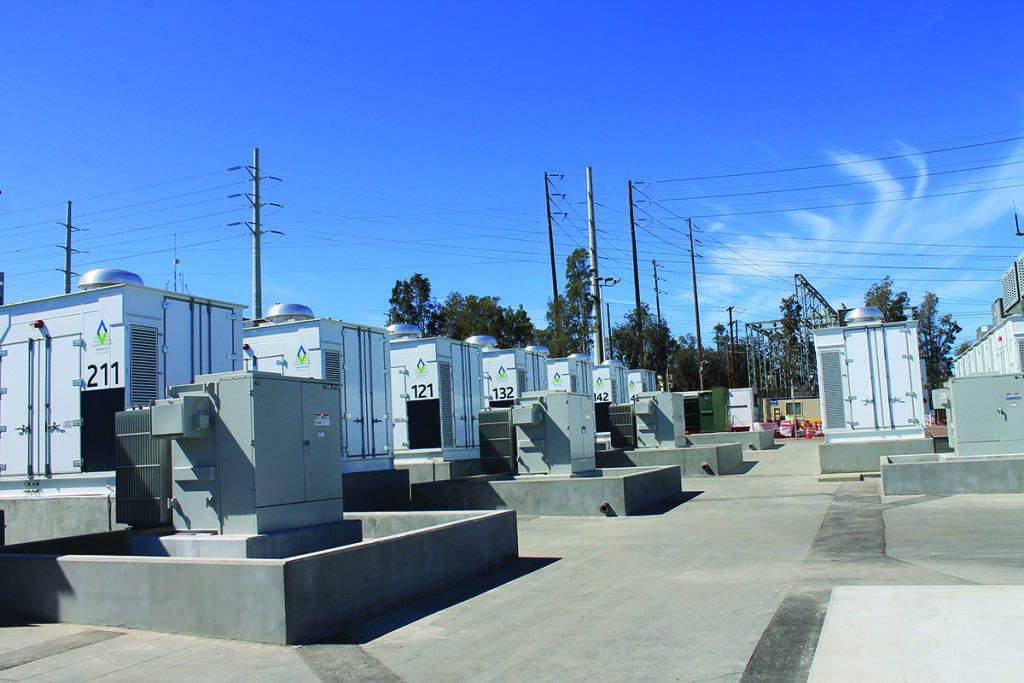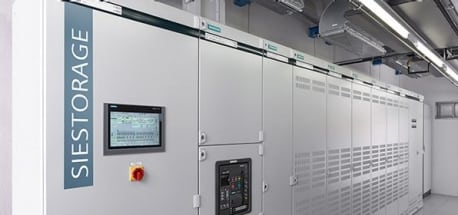AES and Siemens, Two Power Giants, Join Forces on Energy Storage
Underscoring energy storage’s new vital role in power company operations, Siemens and AES Corp. have launched a joint company, Fluence Energy, that provides technology solutions paired with engineering and services capabilities.
AES and Siemens on January 11 announced that Fluence, which merges AES Energy Storage and Siemens’ energy storage team, received all government approvals for the launch. The company will leverage Siemens’ global sales force and market to sell energy storage systems developed by both Siemens and AES, including SIESTORAGE and Advancion, along with a new platform, SunFlex Energy Storage, which caters to solar photovoltaic (PV) power. According to company documents, the partnership gives Fluence access to a sales presence in 160 countries, including thousands of utilities, power developers, and large commercial customers.
The company has already bagged its first order: A 100-MW/400-MWh lithium-ion battery-based storage installation in Long Beach, California. The project with a four-hour duration will serve Southern California Edison and the western Los Angeles area.
In a statement on January 11, Fluence President and CEO Stephen Coughlin said the company was formed to address gaps in the utility-scale energy storage market, whose acceleration in recent years poses a marked disruption to conventional power generation. The value of energy storage is now widely recognized as critical infrastructure that could boost reliability, resilience, and efficiency.
AES and Siemens first announced their partnership in July 2017. The new company’s global headquarters will be in the Washington, D.C., area, with other offices in Erlangen, Germany and worldwide.
“We saw customers struggling to find a trusted technology partner with deep knowledge of the power sector and the ability to deliver an industrial grade solution they could count on to be there in the future,” said Coughlin. “With a team drawn from both Siemens and AES, we are fluent in the power sector and bring the capabilities, global reach and experience to make sure our customers achieve the full value of storage.”
From Holy Grail to Common Solution
Considered for years as a “holy grail” that could transform intermittent forms of energy production into firm, baseload capacity, energy storage developments garnered serious notice by the power sector sometime between 2011 and 2014, a period during which a number of demonstration projects showed various technologies could optimize energy delivery. (For more, see “Battery Storage Goes Mainstream” in POWER’s May 2017 issue.)
According to market research firm IHS Markit, the global energy storage market installed 6 GW in 2017—an exponential increase from the 0.34 GW installed in 2012 and 2013. Experts widely project that this growth will continue. IHS’s forecasts show that annual installations could surge to 40 GW by 2022.
One reason for this soaring growth is that energy storage is now being incorporated broadly into utility planning and power system planning all around the world, as John Zahurancik, who served as president for AES Energy Storage between 2015 and 2017, and is now Fluence’s chief operating officer, told POWER on January 4. “If you look at the resource planning guides that are coming out of major utilities, and if you look at the independent system operator areas and the ways that they’ve incorporated rules changes, they’ve incorporated energy storage,” he said.
Countries like Mexico, which revised its approach to energy regulation, and the UK, which recently revised its capacity mechanism, have also incorporated energy storage. “Japan is opening up to this; you have Australia putting energy storage to respond to crisis conditions; you have the prime minister of India talking about—alongside 100 GW of solar—the need for gigawatts of energy storage to help support the grid,” he added. “So what we see from very developed nations and markets like California and so on, all the way down to high-growth markets like India and developing nations like the Dominican Republic … you see energy storage becoming an accepted tool—and actually a bigger and bigger part of the investment profile.”
However, over the past three years, the storage technology markets—especially battery storage—have suffered a general upheaval. The fledgling sector was also still in a state of flux last year, characterized by multiple mergers and acquisitions. Sam Wilkinson, a senior research manager at IHS Markit, noted that the industry is in a “growth phase.” Today, companies “best positioned for success will require a proven track record, technology expertise, a global service network, and an ability to serve a broad set of energy storage applications,” he said.
As Kelly Speakes-Backman, CEO of the Energy Storage Association (ESA) told POWER on January 5, how storage is being used is also morphing. “The majority of storage deployed today is standalone to support the grid, and co-location with generation is not always necessary to gain the operational efficiencies to generation that storage enables,” she said.
“That said, some companies are co-locating their storage units with existing generators for a variety of reasons, such as taking advantage of siting and permitting efficiencies or availing the investment tax credit for solar-paired projects. Which pathways become dominant will depend, in part, on how public policy and market rules develop.”
Still, she noted: “Operating storage in coordination with generation brings greater flexibility and efficiency. Storage makes variable generation, like wind and solar, into a dispatchable resource. Four- and five-hour batteries paired with solar plants in Arizona and Hawaii are enabling solar to meet evening demands.”
Storage used with conventional generation like nuclear and coal is also showing gains because it transforms them into a more flexible resource, she said. “Most pumped hydro in the U.S. was developed precisely for that reason. And storage paired with mid-merit generation, like gas [combined cycle gas turbines] reduces cycling and enables higher efficiency generation; that’s why you’re seeing companies like GE and Wartsila pairing batteries with gas-fired generation.”
A Good Bet and An Opportunity to Flourish
For AES, energy storage has always seemingly offered a lucrative outlook. A decade ago, the company established a dedicated energy storage division, in 2009, it began commercial operation of the first 12-MW/4-MWh lithium-ion battery system for a spinning reserve project at AES Gener’s Los Andes substation in Chile’s Atacama Desert, and later that year, an 8-MW lithium-ion frequency regulation project at a power plant in Johnson City, New York.
The business took off—in a big way—boosted by the growth of energy storage beyond niche applications. “A few years ago, we began looking for ways to scale up distribution and our reach. We were finding more and more countries around the world turning to energy storage as one of the solutions to many of the challenges that they’re facing in the power sector,” said Zahurancik. To quench this soaring demand and need for attention in many more countries around the world, AES announced some partnerships at the beginning of 2016. “In the course of looking for some other sales distribution partnerships for the energy storage technologies that we had developed, we started to interact with Siemens,” he said.
Siemens had a small energy storage organization in the U.S. as well as in Europe focused on commercial and industrial customers. AES’s primary customers were from utilities. “The more we talked together, the more it seemed like a very strong fit to bring together these two organizations into one company that could address the energy storage market globally,” Zahurancik said.
Fluence is uniquely suited to the power sector, which has been inundated by energy storage startups as interest picked up over the past few years, Zahurancik noted. “It’s difficult to understand whether those companies are going to be around and whether they’re going to have the staying power. There’s a lot of companies kind of doing components and pieces of this. They might come to you with a battery solution. They might even come from another industry, and they’re repurposing their technology into the power grid, but it’s not quite clear that they really understand how storage works in the utility system,” he said.
“Fluence is uniquely suited to that, coming out of AES with a long history of serving power grids around the world and Siemens with an even longer history of being a core supplier to those power systems.”
Zahurancik said that Fluence’s focus will initially fall on two technical platforms: Advancion, AES’s utility-scale platform, which though commercialized just three years ago has been deployed widely, notably at a large 30-MW/120-MWh system in San Diego; and SIESTORAGE, a Siemens–developed modular energy storage system used at numerous commercial and industrial systems worldwide.

On January 11, Fluence also unveiled SunFlex Energy Storage, a new technology platform that promises to capture solar PV generation and increase the volume of energy delivered from a single site by up to 50% by allowing developers to add more solar panels without the cost of changing their interconnection. The platform builds upon controls and architectural principles from Advancion and SIESTORAGE with experience gained from working with leading solar developers such as sPower and AES Distributed Energy. According to Fluence, it also improves plant stability by smoothing and limiting the ramping of solar output, “and in many areas, simplifies the interconnection process for combined solar and storage facilities.”
Fluence also offers an array of services. “We’ll do a full turnkey installation. We can do certain financing services. We’ll do post-installation service improvement and lifecycle management, and we do a lot of work helping the customers integrate storage into their operations so that they can take full advantage of the storage capabilities,” Zahurancik said.
Launching Fluence, a 50-50 joint entity, doesn’t mean AES is exiting the energy storage business, Zahurancik noted. Fluence will give AES’s technology part an opportunity to flourish, allowing AES to focus on what it does in the business development and ownership of power solutions, he said. “What we’re doing now is taking that technical part of the business and spinning it into Fluence, and then at the same time, the AES business development parts of the organization will continue to look for opportunities to deploy storage in projects that the company will own and will operate on behalf of other customers.”
For Siemens, Fluence provides its own outlet in which they can sell developed energy storage technologies in conjunction with other Siemens technologies. “Siemens already builds a lot of the switch gear, transformers, and ancillary electrical equipment that goes along with many of these energy storage systems, and so they can offer that as a package to customers around the world,” Zahurancik said.
—Sonal Patel is a POWER associate editor (@sonalcpatel, @POWERmagazine)
